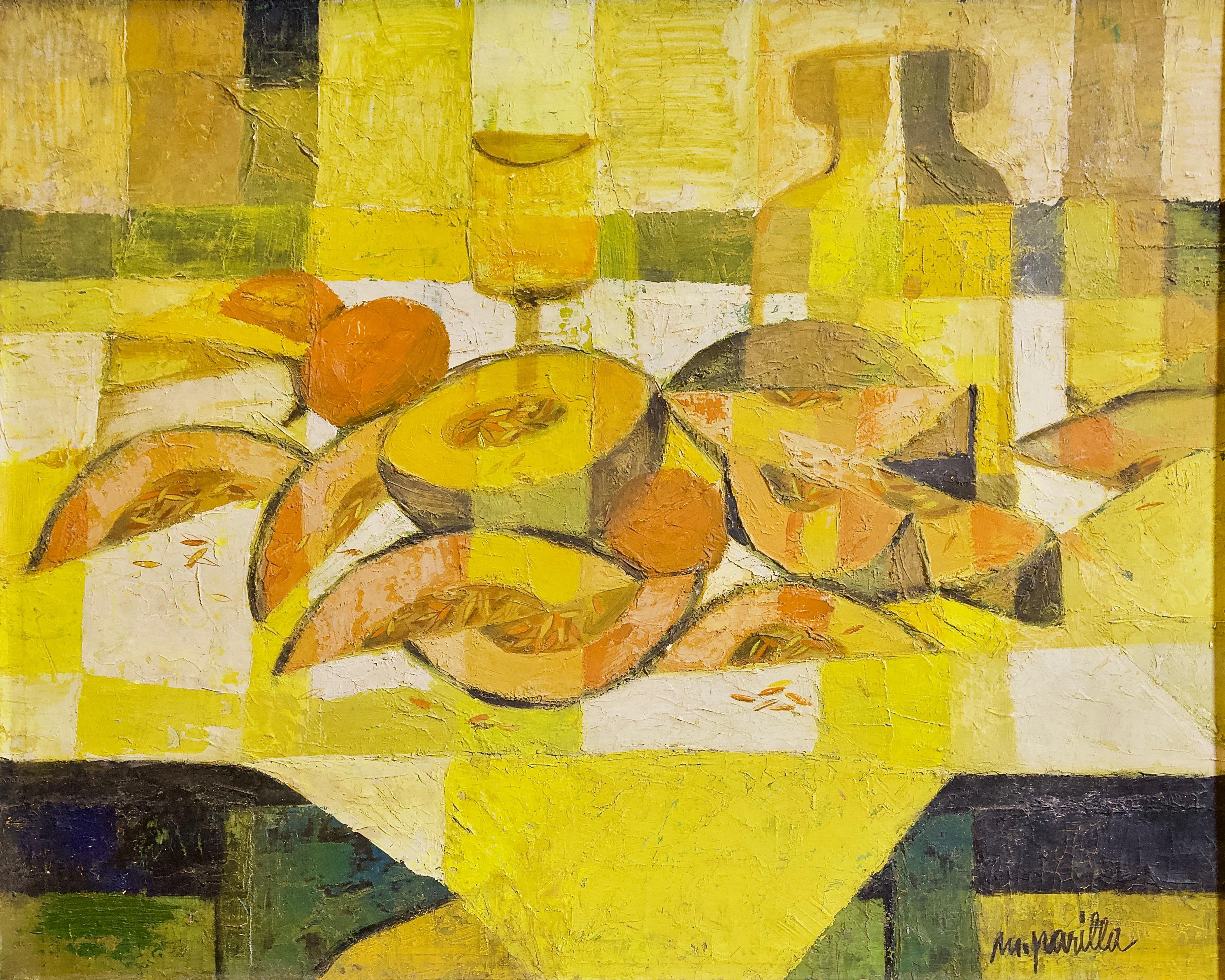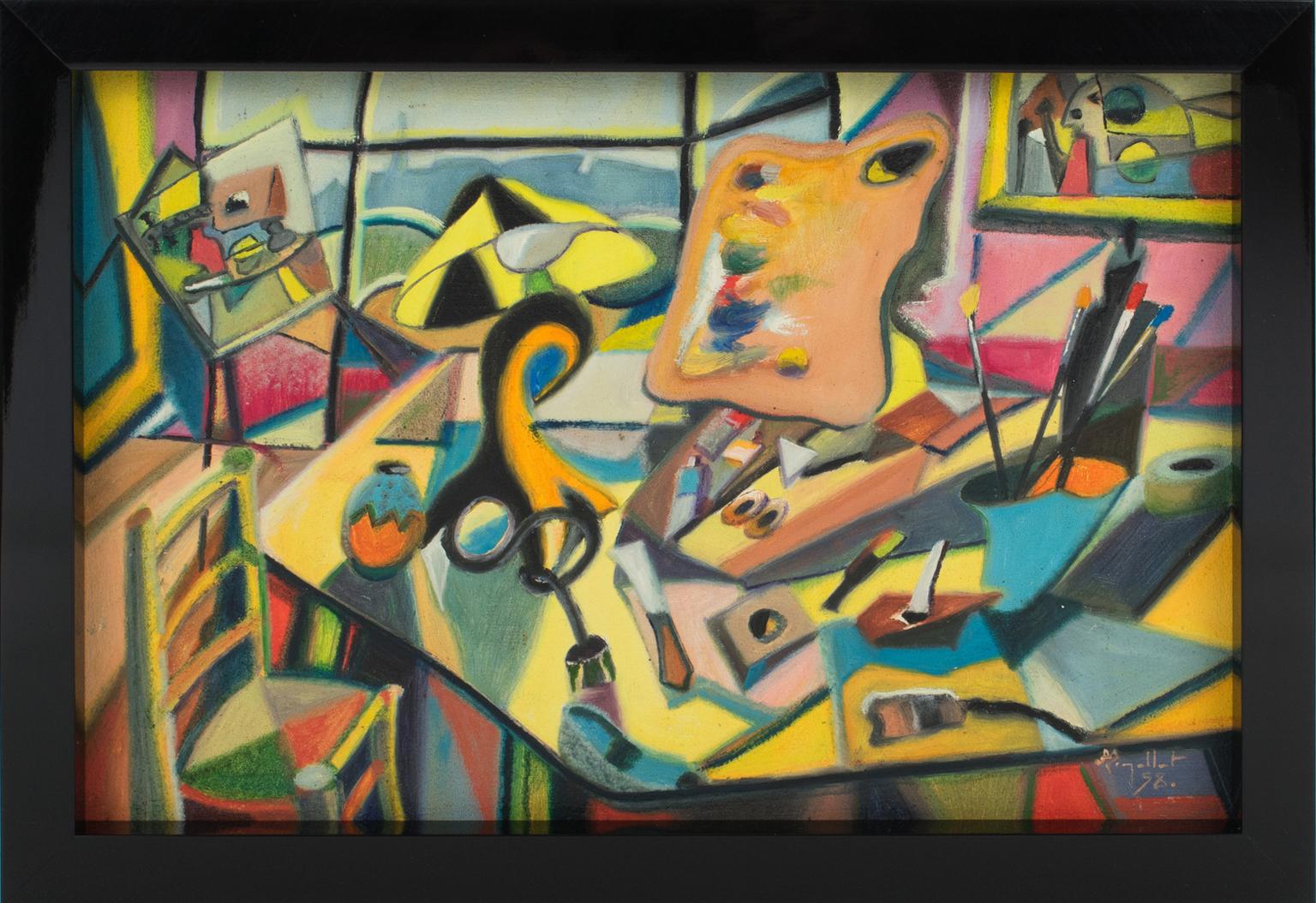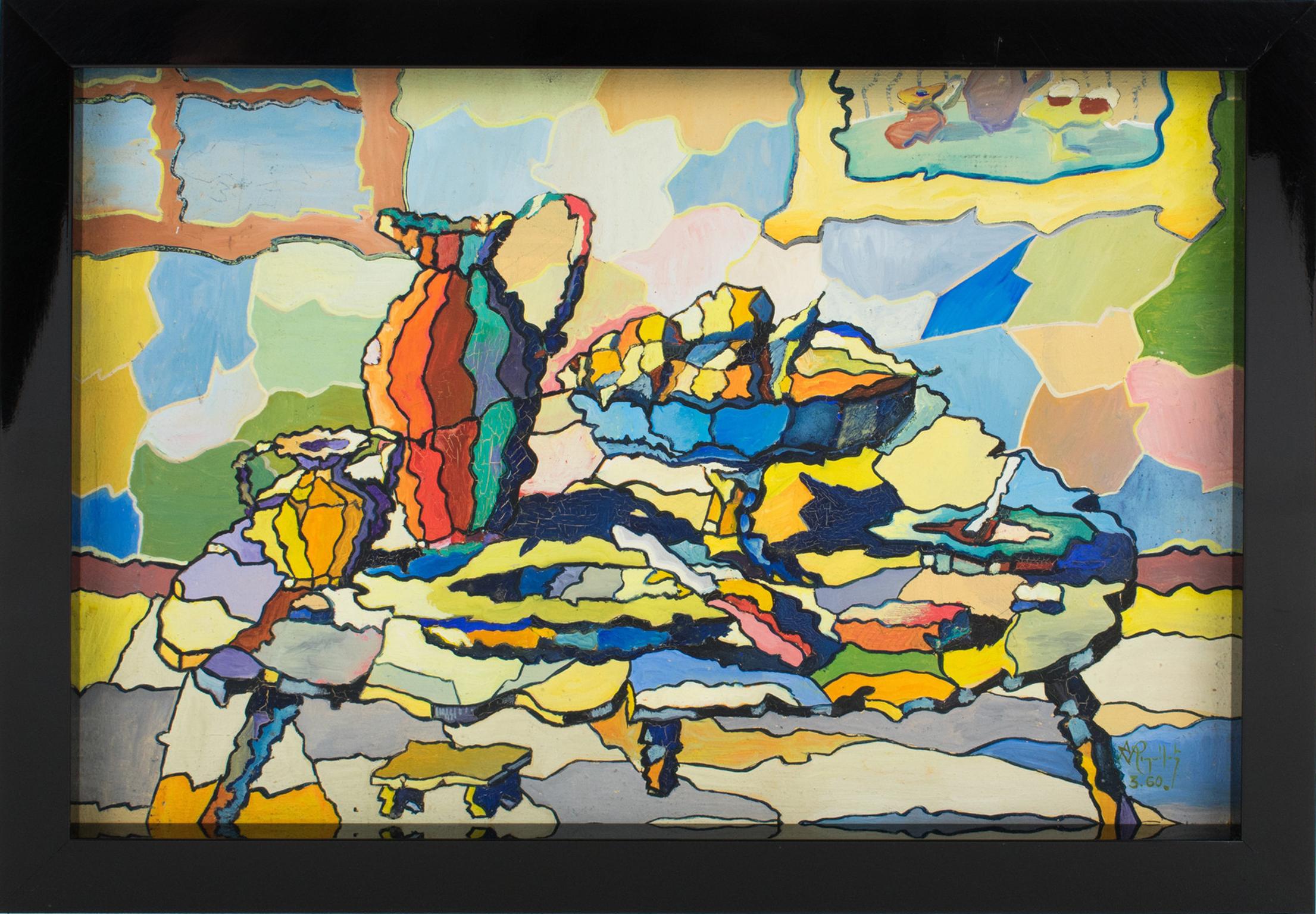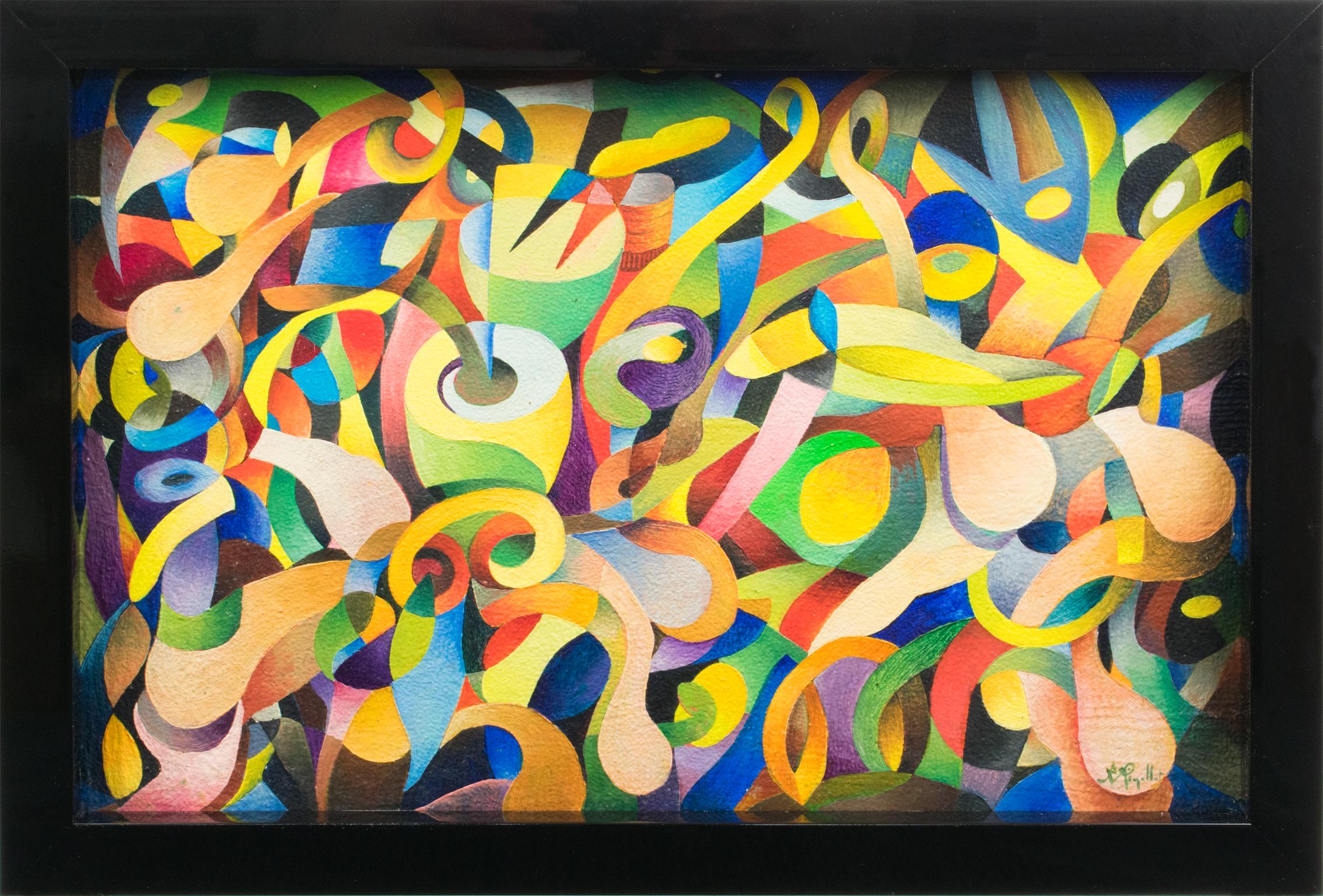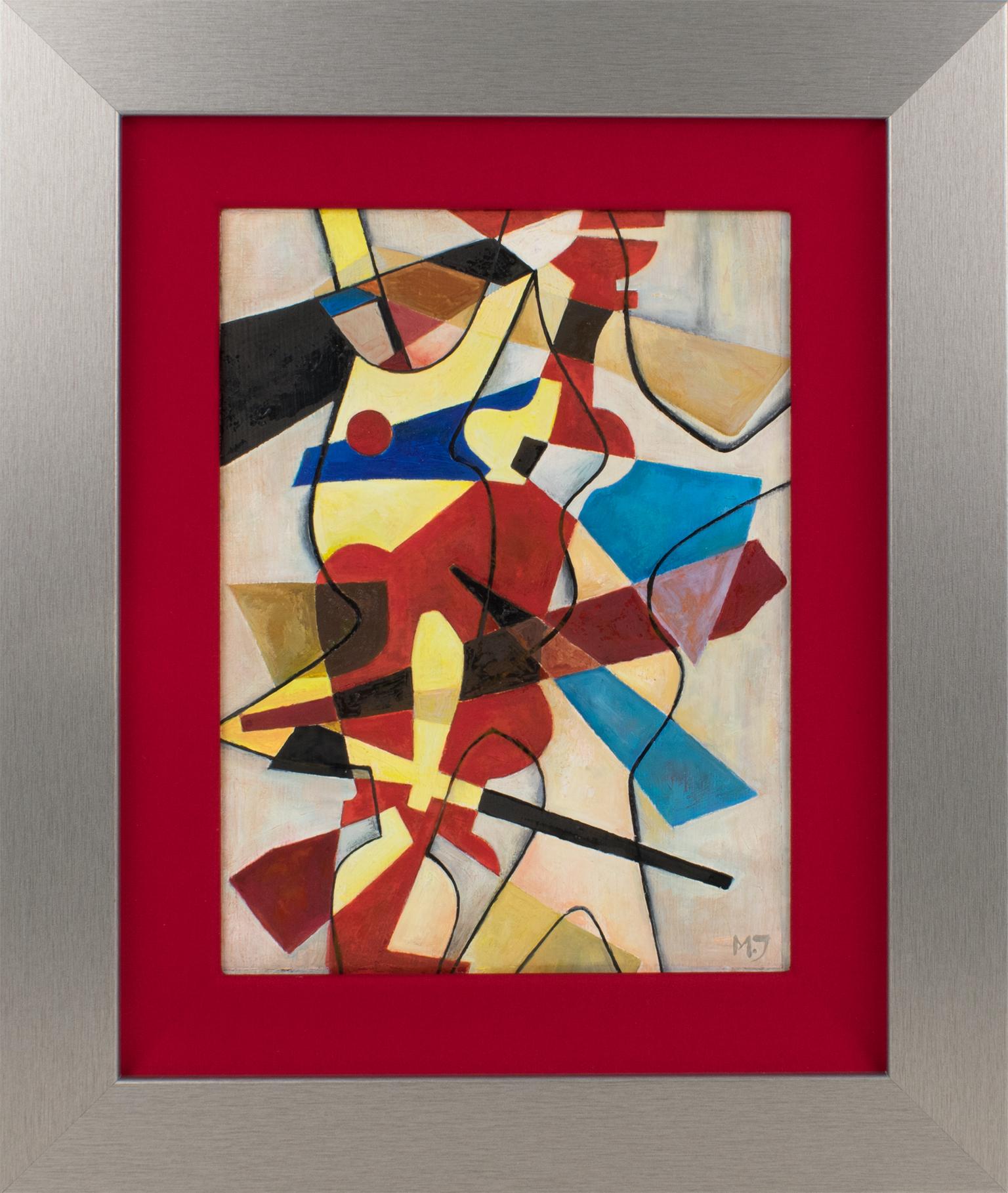Items Similar to "Nature morte" Bela de Kristo, Mid-century Cubist Still Life Abstract Cello
Want more images or videos?
Request additional images or videos from the seller
1 of 9
Bela De Kristo"Nature morte" Bela de Kristo, Mid-century Cubist Still Life Abstract Cellocirca 1956
circa 1956
About the Item
Bela de Kristo
Nature morte, circa 1956
Signed lower right
Oil on board
19 5/8 x 11 3/4 inches
Provenance:
Alexander Kahan Fine Arts, New York
Private Collection, New Jersey (acquired from the above)
- Creator:Bela De Kristo (1920 - 2006)
- Creation Year:circa 1956
- Dimensions:Height: 25 in (63.5 cm)Width: 17 in (43.18 cm)
- Medium:
- Movement & Style:
- Period:
- Condition:
- Gallery Location:New York, NY
- Reference Number:1stDibs: LU1841212157922
About the Seller
5.0
Platinum Seller
These expertly vetted sellers are 1stDibs' most experienced sellers and are rated highest by our customers.
Established in 2021
1stDibs seller since 2022
62 sales on 1stDibs
Typical response time: 1 hour
- ShippingRetrieving quote...Ships From: New York, NY
- Return PolicyA return for this item may be initiated within 3 days of delivery.
More From This SellerView All
- "Candelabra, " Edward Millman, Colorful Abstract Expressionist Still LifeLocated in New York, NYEdward Millman (1907 - 1964) Candelabra, 1962 Signed lower right; titled and dated on the reverse Oil on canvas 41 3/4 x 31 1/2 inches Provenance: The ...Category
1960s Abstract Abstract Paintings
MaterialsCanvas, Oil
- "Mums" William S. Schwartz, Yellow Flowers, Cubist, Modern Still LifeBy William S. SchwartzLocated in New York, NYWilliam S. Schwartz Still Life with Yellow Mums, circa 1950 Signed lower right Oil on canvas 20 x 16 inches Provenance: Private Collection, Massachusetts William Schwartz was born in Smorgon, Russia, in 1896, one of nine children in a poor family. He studied art at an early age, earning a scholarship at the Vilna Art School in Russia, 1908–12. He immigrated to the United States at age 17 in 1913, living in New York with his sister for eight months and then moving to Omaha, Nebraska, to live with his brother in 1915. Working as a house painter, he turned his attention to art, studying briefly with J. Laurie Wallace at the Kellom School in Omaha before moving to Chicago. He entered the School of the Art Institute of Chicago (SAIC) in 1916, studying with Ivan Trutnev and Karl A. Buehr, and graduating with honors in life drawing, portraiture, and painting in 1917. He supported himself as a tenor singer in vaudeville, concerts, and opera and received favorable reviews, but he chose to pursue painting instead of singing. His circle of artist friends included important Chicago modernists Aaron Bohrod, Malvin and Ivan Albright, Archibald Motley Jr., and Anthony Angarola...Category
Mid-20th Century Cubist Still-life Paintings
MaterialsCanvas, Oil
- "Tabac" Charles Green Shaw, Tobacco, Smoking, Park Ave Cubist, AAABy Charles Green ShawLocated in New York, NYCharles Green Shaw Tabac, circa 1935 Signed on the reverse Oil on canvasboard 5 3/4 x 8 3/4 inches Provenance: Washburn Gallery, New York, 1982 Private Collection (acquired from the above) Christie's, The Collector, October 20, 2021, Lot 307 Private Collection, Scarsdale, New York (acquired directly from the above) Literature: Hilton Kramer, "Charles Shaw: In the Minimal Tradition," New York Times, February 21, 1982, Section 2, p. 25. Charles Green Shaw was born in 1892 to a wealthy New York family. He lost both his parents at a very young age; his mother died when he was just three years old. Despite the early loss of his parents, Shaw lived the whimsical life of a New York socialite. As a beneficiary to an inheritance based in part upon the Woolworth fortune, he was brought up surrounded by the well-bred, well-groomed and well-moneyed citizens of New York’s elite social class. His social status as an adolescent was cultivated while spending summers in Newport and attending Christmas balls at Mrs. W.K. Vanderbilt’s. At age six, Shaw began to take an interest in drawing, and by nine, he was known to have a fondness for sketching historical costumes. After graduating from Yale University in 1914, Shaw spent a year studying at Columbia University’s School of Architecture. Subsequently he served for eighteen months as a Lieutenant in World War I. After his service, Shaw returned to New York and tried his hand as a businessman selling real estate, but his attempt was short lived. In the early 1920s, Shaw began his career as a journalist and novelist. He achieved professional success, writing consistently for magazines such as The New Yorker, Vanity Fair and The Smart Set. Shaw’s writing was a record of his approvals and disapprovals of the social crowd to which he belonged. His profession along with his social pedigree, brought him in contact with a number of the most significant figures of the 1920s such as, F. Scott Fitzgerald, Sinclair Lewis, George Gershwin, George Jean Nathan and the American artist George Luks. Some of his profiles included celebrity caricatures used as illustrations, these were the publics’ first look at Shaw’s artistic ability. In 1928, a collection of Shaw’s articles and interviews were published in one volume titled, The Low Down. Just previous to the stock market crash and the end of the Jazz Age, Shaw left New York and traveled to Paris and London. He arrived in Paris in 1929. In an autobiographical note Shaw suggests it was on this trip when he first began to paint seriously. London also acted as a great source of motivation for the budding artist. He began to sketch everyday in St. James’s Park, making large pastels of its vistas in the style of Cezanne. When he returned to New York in 1932, Shaw considered himself a painter. Success for Shaw came quickly with his first solo exhibition mounted at the Valentine Gallery in 1934. The following year Albert Eugene Gallatin included works by the artist in an unprecedented solo exhibition at his Gallery of Living Art at New York University. Shaw further cemented his reputation as an artist through his association and friendship with fellow abstract artists Morris and Gallatin. The trio soon was regarded as ‘the Park Avenue Cubists’. As a founding member of the American Abstract Artists, Shaw became an impassioned defender of the style. His 1938 essay in the American Abstract Artists yearbook, “A Word to the Objector”, acted as a defense against those who failed to see the illustrative quality of abstract art and scolded those who disregarded American artists as serious Abstractionists. He was also an influential force at the Museum of Modern Art, where he sat on the Advisory Board from 1936 to 1941. In the later years of Shaw’s life he continued to produce abstract paintings, yet in a more private manner. He was known to be a reserved man— a ‘gentleman’; not much is known about his personal life in these later years. During this time he maintained his career as a writer, publishing the well-known children’s book, It Looked Like Spilt Milk in 1940 and two books of poems in 1959 and 1962. In 1974, Shaw died...Category
1930s Cubist Landscape Paintings
MaterialsOil, Board
- "Faun and Fawn" Aaron Bohrod, Realist Still Life, Deer and PuttiBy Aaron BohrodLocated in New York, NYAaron Bohrod Faun and Fawn, 1984 Signed lower right Oil on gesso board 16 x 12 inches Aaron Bohrod's work has not been limited to one style or medium. Initially recognized as a regionalist painter of American scenes, particularly of his native Chicago, Bohrod later devoted himself to detailed still-life paintings rendered in the trompe l'oeil style. He also worked for several years in ceramics and wrote a book on pottery. Born in 1907, Bohrod began his studies at Chicago's Crane Junior College in 1925, and two years later enrolled in the Art Institute of Chicago. But it was at the Art Students League in New York City, from 1930 to 1932, that he studied under the man believed to be his most significant early influence, John Sloan. Sloan's romantic realism is reflected in the many depictions of Chicago life, which comprised most of Bohrod's early work. Under Sloan's tutelage, Bohrod came to subscribe to the belief that painters should find the subjects of their art in the immediate world around them. These paintings emphasized architecture unique to north Chicago and featured Chicagoans engaged in such everyday activities as working, playing or going to the theatre. The romantic aspect was conveyed by the use of misty colors, and the realism by attention to detail. In 1936, Bohrod won the Guggenheim Fellowship award in creative painting...Category
1980s Realist Animal Paintings
MaterialsBoard, Oil
- "Footnotes" Aaron Bohrod, Pun Humor, Shoes, Realist Trompe L'oeil Still LifeBy Aaron BohrodLocated in New York, NYAaron Bohrod Footnotes, 1990 Signed lower right Oil on gesso board 20 x 16 inches Aaron Bohrod's work has not been limited to one style or medium. Initially recognized as a regiona...Category
1990s Realist Animal Paintings
MaterialsBoard, Oil
- "Objets d'Arctic" Aaron Bohrod, Inuit, Polar Bear, Penguin, Winter Still LifeBy Aaron BohrodLocated in New York, NYAaron Bohrod Objets D'Arctic, 1987 Signed lower right Oil on gesso board 14 x 11 inches Aaron Bohrod's work has not been limited to one style or medium. Initially recognized as a regionalist painter of American scenes, particularly of his native Chicago, Bohrod later devoted himself to detailed still-life paintings rendered in the trompe l'oeil style. He also worked for several years in ceramics and wrote a book on pottery. Born in 1907, Bohrod began his studies at Chicago's Crane Junior College in 1925, and two years later enrolled in the Art Institute of Chicago. But it was at the Art Students League in New York City, from 1930 to 1932, that he studied under the man believed to be his most significant early influence, John Sloan. Sloan's romantic realism is reflected in the many depictions of Chicago life...Category
1980s Realist Animal Paintings
MaterialsBoard, Oil
You May Also Like
- Decorative, Abstract Oil Painting, Cubic Still Life, with Honeydew Melons.Located in Berlin, DEHighly Decorative, Abstract Oil Painting, Still Life with Honeydew Melons. The painting was most likely made in the USA. (See reverse side, manufacturer of the cardboard). Signed. U...Category
20th Century Cubist Abstract Paintings
MaterialsOil, Cardboard
- The Painter's Studio, Colorful Post-Cubist Oil Painting by A. RigollotBy A. RigollotLocated in Atlanta, GAStunning post-cubist and colorist still life oil on board painting by A. Rigollot (France, 20th Century). Colorist painting is characterized by the use of intense color, which become...Category
1950s Cubist Still-life Paintings
MaterialsBoard, Oil
- Kaleidoscope Abstract Still Life Post-Cubist Oil Painting by A. RigollotBy A. RigollotLocated in Atlanta, GAThis incredible post-cubist and colorist still life oil on board painting was designed by A. Rigollot (France, 20th Century). Colorist paintings are characterized by intense color us...Category
1960s Cubist Still-life Paintings
MaterialsOil, Board
- "Idole" Multicolor Post-Cubist Oil Painting by A. RigollotBy A. RigollotLocated in Atlanta, GAThis mesmerizing post-cubist and colorist abstract oil on board painting was designed by A. Rigollot (France, 20th Century). Colorist paintings are characterized by intense color use...Category
1960s Cubist Still-life Paintings
MaterialsOil, Board
- "Twist" Colorful Abstract Post-Cubist Oil Painting by A. RigollotBy A. RigollotLocated in Atlanta, GAA. Rigollot (France, 20th Century) designed this superb post-cubist and colorist abstract oil on board painting. Colorist painting is characterized by intense color use, which become...Category
1960s Cubist Still-life Paintings
MaterialsOil, Board
- Multicolor Abstract Cubist Oil Painting with Monogram Signature MJLocated in Atlanta, GAThis stylish abstract cubist oil on board painting with a monogram signature "M.J." is from a German artist (20th Century). The colorful painting features a stylized abstract composi...Category
1950s Cubist Still-life Paintings
MaterialsOil, Board
Recently Viewed
View AllMore Ways To Browse
8 X 11
Mid Century Cubist
Mid Century Painting Cubist
Cubist Still Life Art
Cubist Painting Board
Mid Century Abstract Cubist Painting
Mid Century Cubist Oil
Nature Morte
Nature Morte Painting
Cello Used
Cello Art
Nature Morte Oil Paintings
Vintage Cello
Nature Morte Still Life Art
Cello Painting
Mid Century Oil Painting Flower
Flower Oil Paintings Mid Century
Six Still Life Paintings
